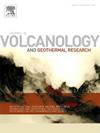Geothermal gas geochemistry in Southeast Tibetan Plateau margin influenced by magma chambers and fractures
IF 2.3
3区 地球科学
Q2 GEOSCIENCES, MULTIDISCIPLINARY
Journal of Volcanology and Geothermal Research
Pub Date : 2025-03-28
DOI:10.1016/j.jvolgeores.2025.108323
引用次数: 0
Abstract
Hydrothermal gases play a pivotal role in elucidating the cycling of deep materials and subsurface processes. Here, we analyzed the chemical and isotopic compositions of 40 gas samples and compiled geochemical data on >280 samples discharged from the Tengchong hydrothermal field, located on the Southeast Tibetan Plateau margin. Helium isotopes span from 0.13 Ra (the 3He/4He ratio of air) to 5.91 Ra, indicating a mixing between mantle-derived helium and crustal components. Spatial distributions of helium isotopes are closely associated with the locations of magma chambers beneath the Tengchong field. N2/Ar ratios and nitrogen isotopic compositions suggest that N2 and Ar were primarily contributed by atmospheric sources and groundwater, with minor N2 contributions from mantle-derived materials. CO2 was mostly originated from the thermal decomposition of limestone and magma degassing, with a few samples affected by secondary processes like carbonate precipitation. The chemical and carbon‑hydrogen isotopic compositions of alkanes indicate that methane was mainly sourced from thermogenic processes. The central magma chamber and its adjacent faults are characterized by the most intensive magmatic activity and the closest connection to deep materials. A gas migration and diffusion model using a crustal 3He endmember of 6 × 10−9–9 × 10−8 (volume ratio of 3He to total gases) well explains the decreasing 3He concentrations with the distance from magma chambers. Hence, the highly penetrable helium in quiescent regions like Tengchong could migrate through overlying rocks without the need of gas channeling along faults. Similarly, our model can also explain the relationships between Ar concentrations and the distance from springs to faults and magma chambers. In contrast, the geochemical characteristics of other gas components (e.g., CO2, N2) are closely associated with the location of major faults. This study offers valuable insights into the spatial relationships between gas geochemistry and subsurface magmatism and fault distribution, highlighting the influence of hydrothermal processes on diverse patterns of gas migration and source in hydrothermal fields.
青藏高原东南缘岩浆库与裂缝影响下的地热气体地球化学
热液气体在阐明深部物质循环和地下过程中起着关键作用。本文对青藏高原东南缘腾冲热液田排出的40份天然气样品进行了化学同位素分析,并编制了280份样品的地球化学数据。氦同位素范围从0.13 Ra(空气的3He/4He比)到5.91 Ra,表明地幔衍生的氦和地壳成分混合。腾冲地区氦同位素的空间分布与岩浆库的位置密切相关。N2/Ar比值和氮同位素组成表明,N2和Ar主要由大气源和地下水贡献,地幔源物质对N2的贡献较小。CO2主要来源于石灰岩热分解和岩浆脱气,少数样品受碳酸盐沉淀等二次作用的影响。烷烃的化学组成和碳氢同位素组成表明甲烷主要来源于热作用。中央岩浆房及其邻近断裂的特征是岩浆活动最强烈,与深部物质联系最密切。利用6 × 10−9-9 × 10−8 (3He与总气体的体积比)的地壳3He端元的气体迁移和扩散模型很好地解释了3He浓度随离岩浆房距离的增加而降低的现象。因此,在腾冲这样的静止区,高渗透性的氦气可以穿过上覆岩石运移,而不需要沿着断层输送气体。同样,我们的模型也可以解释氩浓度与泉水到断层和岩浆库的距离之间的关系。相反,其他气体组分(如CO2、N2)的地球化学特征与主要断裂的位置密切相关。该研究为天然气地球化学与地下岩浆活动和断裂分布的空间关系提供了有价值的见解,突出了热液过程对热液田多种天然气运移模式和来源的影响。
本文章由计算机程序翻译,如有差异,请以英文原文为准。
求助全文
约1分钟内获得全文
求助全文
来源期刊
CiteScore
5.90
自引率
13.80%
发文量
183
审稿时长
19.7 weeks
期刊介绍:
An international research journal with focus on volcanic and geothermal processes and their impact on the environment and society.
Submission of papers covering the following aspects of volcanology and geothermal research are encouraged:
(1) Geological aspects of volcanic systems: volcano stratigraphy, structure and tectonic influence; eruptive history; evolution of volcanic landforms; eruption style and progress; dispersal patterns of lava and ash; analysis of real-time eruption observations.
(2) Geochemical and petrological aspects of volcanic rocks: magma genesis and evolution; crystallization; volatile compositions, solubility, and degassing; volcanic petrography and textural analysis.
(3) Hydrology, geochemistry and measurement of volcanic and hydrothermal fluids: volcanic gas emissions; fumaroles and springs; crater lakes; hydrothermal mineralization.
(4) Geophysical aspects of volcanic systems: physical properties of volcanic rocks and magmas; heat flow studies; volcano seismology, geodesy and remote sensing.
(5) Computational modeling and experimental simulation of magmatic and hydrothermal processes: eruption dynamics; magma transport and storage; plume dynamics and ash dispersal; lava flow dynamics; hydrothermal fluid flow; thermodynamics of aqueous fluids and melts.
(6) Volcano hazard and risk research: hazard zonation methodology, development of forecasting tools; assessment techniques for vulnerability and impact.

 求助内容:
求助内容: 应助结果提醒方式:
应助结果提醒方式:


